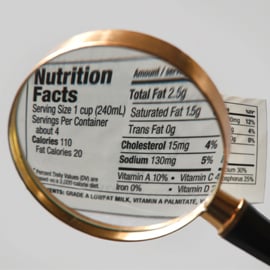Food labels are printed in an easy-to-read grid on the back or side panel of every bag, box or bottle of food you purchase. These labels hold the information you need to know about the food you are going to eat. Paying close attention to these labels can help you make smarter food choices after weight loss surgery.
Food labels break down information like:
- Calorie content
- Nutritional value
- Serving size

This information will be helpful to you after weight loss surgery. Paying attention to food labels can help you make healthier choices as you focus on losing weight.
Why Read Food Labels?
By reducing the size of your stomach available to hold food, bariatric surgery makes it difficult to eat more than a few ounces of food at a time and helps you fee full for longer between meals.
The goal of weight loss surgery is to help you eat less and thereby cut calories to encourage weight loss. However, your body’s need for nutrients won’t change. As you cut calories, you’ll have to pay extra attention to the foods you eat to ensure that you are maximizing nutrient intake. Food labels can help you accomplish this.
What to Look for?
There are a few key points you’ll want to look for on your food labels. This includes the calorie count, amount of protein and recommended serving size.
Here are a few tips to help you find this information:
- Look at the calories: The top of the food label lists the amount of calories and the serving size. Remember that the more calories there are in an item, the more likely it is to fill you up. You want low calorie, nutrient dense foods in your diet after weight loss surgery.
- Consider the serving size: Serving size is listed just under the calorie level. The calorie and nutrient values listed are per serving. If you only eat half a serving, you are only getting half of that nutrient value.
- Check the nutrients: Food labels will list all nutrients and will tell you how much (if any) you’ll get per serving. Protein is especially important after weight loss surgery because it helps preserve muscle strength.
On the right hand side of the food labels you’ll see percentage marks. These tell how much of your recommended daily value of each nutrient this item will provide you. With a reduced calorie diet after weight loss surgery, the percentages are not likely to be exactly correct for you. However, you can use these as guidelines. Any percentage over 20 percent is considered a high level of the indicated nutrient, while less than five percent is low. Use this information to make healthier choices as you lose weight.
Suggested Reading
The Best Foods for Protein
Taking Supplements after Weight Loss Surgery
Make Cooking Easier after Bariatric Surgery
Also In This Section
- Quality over Quantity in the Post-Bariatric Surgery Diet
- Dining Choices after Weight Loss Surgery
- Fighting Food Cravings after Weight Loss Surgery
- At the Market after Weight Loss Surgery
- Be Happy with Your Healthy Diet after Bariatric Surgery
- Stress-Free Bariatric Dining
- Emotional Eating: Separate Feelings from Food
- Why Olympic Athletes Skip Sports Drinks
- Everybody’s Going Coconuts
- Think Smart at the Farmers Market
- Three Nutritious Whole Grain Alternatives
- Control Your Portions with 10 Simple Tricks
- Limit your Menu to Lose Weight
- Post-Bariatric Surgery Diet
- Avoid These Foods after Bariatric Surgery
- Long-Term Diet Guidelines for After Weight Loss Surgery

